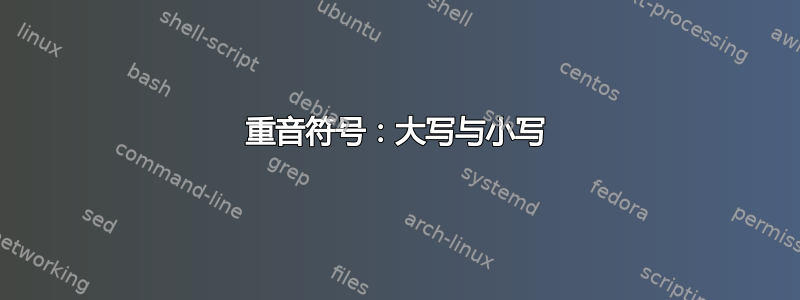
大写字母上的锐音符和重音符比小写字母上的锐音符和重音符更矮更平。\'A与比较\'a。如果我想将其隔离,大写字母上的矮锐音符/重音符的代码是什么?
理由:我需要带有长音符和重音符的大写字母。如果我将 放在\'{}之上\=A,那么字母对于行间距来说太高了,部分原因是\'{}会产生 45 度重音符\'a(部分原因是长音符的默认高度太高)。
\documentclass[12pt]{article}
\begin{document}
If the difference between the accents of \'A, \'a isn't apparent, try superimposing
them: \makebox[0pt]{\'A}\makebox[0pt]{\raisebox{.6ex}{\'a}}\,\raisebox{.6ex}{\'a}.
See how the character on the left has a wedge (as opposed to the acute on the
right-hand \'a)? The two accents don't exactly overlay, because the acute on
\'A is flatter.
\end{document}

答案1
您会发现在编码中用于大写字母的独立尖音符TS1,它被称为\capitalacute:
\documentclass{article}
\usepackage[T1]{fontenc}
\usepackage{textcomp}
\begin{document}
\capitalacute{A}\'{A}\\
\capitalacute{}\'{}\\
{\fontencoding{TS1}\selectfont\char 1}\char1
\end{document}

答案2
您也许能够使用倾斜尺寸进行微调。

以下是我针对类似问题的一些代码:
\documentclass[10pt]{article}
\usepackage{graphicx}
\begin{document}
\font \romanfont=cmr10
\font\specroman=cmr10
%% Next, the special registers
\newdimen\savedvalue
\savedvalue=\fontdimen5\romanfont
\newdimen\specialvalue
\specialvalue=4.75pt
%% Finally, definitions.
\def\specrm{%
\aftergroup\restoredimen
\fontdimen5\specroman=\specialvalue
\specroman }
\def\restoredimen{%
\fontdimen5\romanfont=\savedvalue }
\scalebox{10}{\romanfont \'A} {\scalebox{10}{\specrm \' A}}
\medskip
{\noindent\obeylines\specrm
the value of fontdimen1 (slant) is \the\fontdimen1\font
the value of fontdimen2 (interword space) is \the\fontdimen2\font
the value of fontdimen3 (interword stretch) is \the\fontdimen3\font
the value of fontdimen4 (interword shrink) is \the\fontdimen4\font
the value of fontdimen5 (x-height) is \the\fontdimen5\font
the value of fontdimen6 (quad width) is \the\fontdimen6\font
the value of fontdimen7 (extra space) is \the\fontdimen7\font
}
\medskip
\font \romanfont=cmr10
\font\specroman=cmr10
%% Next, the special registers
\newdimen\savedvalue
\savedvalue=\fontdimen1\romanfont
\newdimen\specialvalue
\specialvalue=0.15pt
%% Finally, definitions.
\def\specrm{%
\aftergroup\restoredimen
\fontdimen1\specroman=\specialvalue
\specroman }
\def\restoredimen{%
\fontdimen1\romanfont=\savedvalue }
\scalebox{10}{\romanfont \'A} {\scalebox{10}{\specrm \' A}}
\medskip
{\noindent\obeylines\specrm
the value of fontdimen1 (slant) is \the\fontdimen1\font
the value of fontdimen2 (interword space) is \the\fontdimen2\font
the value of fontdimen3 (interword stretch) is \the\fontdimen3\font
the value of fontdimen4 (interword shrink) is \the\fontdimen4\font
the value of fontdimen5 (x-height) is \the\fontdimen5\font
the value of fontdimen6 (quad width) is \the\fontdimen6\font
the value of fontdimen7 (extra space) is \the\fontdimen7\font
}
\end{document}
还有一个包你可以看看https://github.com/zellyn/accentbx
答案3
您的 MWE 没有显示您在图片中显示的问题。我已对其进行了调整,以便它能够显示:
\documentclass[12pt]{article}
\begin{document}
If the difference between the accents of \'A, \'a isn't apparent, try superimposing
them: \makebox[0pt]{\'A}\makebox[0pt]{\raisebox{.6ex}{\'a}}\,\raisebox{.6ex}{\'a}.
See how the character on the left has a wedge (as opposed to the acute on the
right-hand \'a)? The two accents don't exactly overlay, because the acute on
\'A is flatter.
\makebox[0pt]{\'A}\makebox[0pt]{\raisebox{.6ex}{\'a}}\,\raisebox{.6ex}{\'a}
\fontencoding{T1}\selectfont
\makebox[0pt]{\'A}\makebox[0pt]{\raisebox{.6ex}{\'a}}\,\raisebox{.6ex}{\'a}
\end{document}

正如您在修改后的 MWE 中的图像中看到的,使用默认的 OT1 编码,重音字符是通过将重音字符放在基数上来生成的,因此重音看起来相同。在最后一行中使用 T1 编码,这在每个字体中使用了两倍的字形,包括设计重音字符 EC 字体设计中大写字母采用略微平坦的重音设计。


